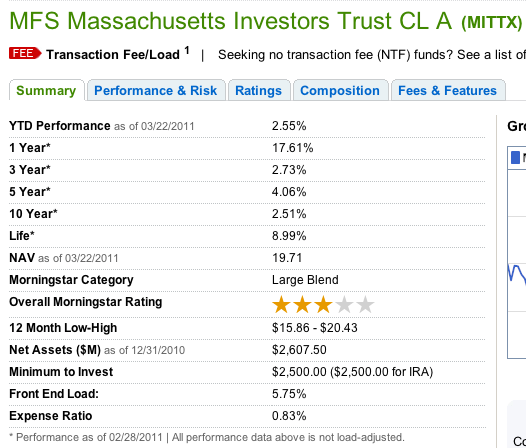Digging Deeper The Mutual Fund Prospectus
Post on: 30 Апрель, 2015 No Comment

As a mutual fund investor, you’ve probably heard it said more than once that you should always consult a mutual fund’s prospectus before handing over your money. It’s no secret, however, that the size of this document and the type of information inside can be hard to tackle. But don’t be too overwhelmed. Here is a guide to what a prospectus is, why it is important and what items should be central to your considerations.
More from Investopedia:
What Is a Mutual Fund Prospectus?
A mutual fund prospectus is a document detailing the investment objectives and strategies of a particular fund or group of funds, as well as the finer points of the fund’s past performance, managers and financial information. You can obtain these documents directly from fund companies through mail, email or phone. You can also get them from a financial planner or advisor. Many fund companies also provide PDF versions of their prospectuses on their websites.
Knowing What to Look For
A prospectus is a legally binding contract between the fund itself and the fundholder. It’s easy to get lost in all the legal jargon and miss the information that matters most to you, so here is an outline of sections to which you should pay special attention. Note that the way in which a fund’s prospectus information is organized may vary from fund to fund; however, by law, all prospectuses must contain the following important sections:
Investment Objectives
These are the fund’s financial goals, which are reflected in the types of securities chosen to achieve those goals. Types of investment objectives include long-term capital growth, stable income, high total return, etc. Fund companies cannot change these objectives unless investors of the fund consent to the changes through a vote.
It is important to determine whether the fund’s goals match your own investment goals. For example, a fund with an above-average capital growth objective would probably not be a good fit for an 89-year-old widow who needs regular income from investments to cover day-to-day expenses.
Investment Strategies
This part of the prospectus explains the way in which a fund allocates and manages its resources to achieve its investment objectives. Aspects considered when designing such a strategy include setting goals for net asset value, determining asset allocation, investment restrictions (such as only investing in a certain industry) and deciding whether (and how) derivatives may be used.
A fund’s investment strategy, like its goals, should be in sync with your investment style. For example, although a small cap fund and a large cap equity fund are both aiming for long-term capital appreciation, they are both using very different strategies to reach this goal. Before choosing one type of fund over another, make sure you consider why investing in any one of these asset types is right for you. Otherwise, you might be in for some surprises!
Risks of Investing in the Fund
Because investors have varying degrees of risk tolerance, the risk section of a prospectus is very important. It details the risks associated with a particular fund, such as credit risk, interest rate risk, market risk, etc.

To get the most out of this section, you should be familiar with what distinguishes the different kinds of risk, why they are associated with particular funds, and how they fit into the balance of risk in your overall portfolio. For example, if a fund invests a large portion of its assets into foreign securities, you need to understand that this may pose significant foreign-exchange and country risk — but you also need to determine whether this kind of risk works with other types of risk in your portfolio in satisfying your tolerance.
Past Performance
This section shows you the fund’s track record, but do remember the common disclaimer that past performance is not an indication of future performance. Read the historical performance of the fund critically and make sure to take into account both long- and short-term performance. Also, make sure the benchmark chosen by the fund is appropriate. For example, using the performance of federal Treasury bills as a benchmark for an equity fund is useless — the S&P 500 is generally the accepted benchmark for equities. In addition, keep in mind that many of the returns presented in historical data don’t account for tax, or some funds calculate an after-tax return with a rate that may be higher or lower than your own. Be sure to look at any fine print in these sections, as they should say whether or not taxes have been taken into account.
Distribution Policy
The distributions a fund pays its investors come from realized capital gains, dividends, interest or other income stemming from the securities and investing activities of the fund. The distribution policy tells you how these payments are made. Some funds distribute returns directly to unitholders, while others reinvest the distributions back into the fund, buying more units for fundholders.
Whether these distributions are paid in cash or reinvested, unitholders have to pay taxes on them. If you are concerned about taxes, there are tax-managed funds that limit income and capital gain distributions. These tax-managed funds allow you to ensure that you maximize the use of your tax-sheltered options, such as your 401(k) or IRA.
Fees and Expenses














